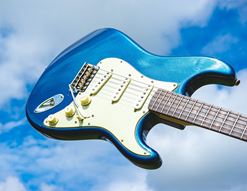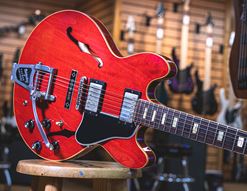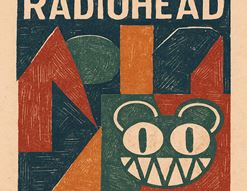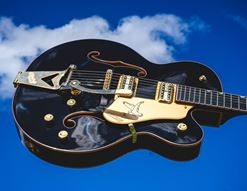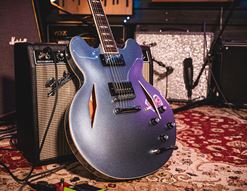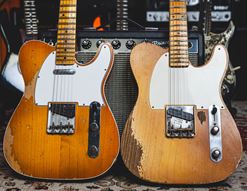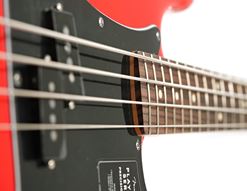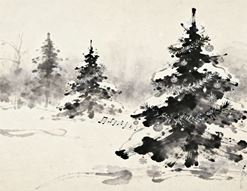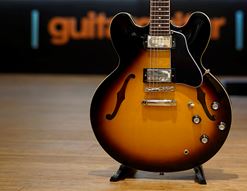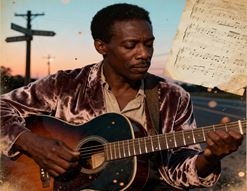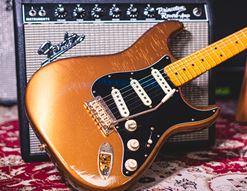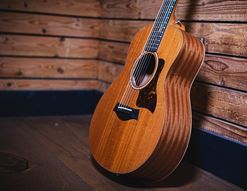The guitar is one of the most well-travelled instruments in the world. Everywhere it finds itself, it gets incorporated into the local music and becomes intrinsically linked with that style. Today, I’ll cover some of these exotic locales and talk about the guitar music that spawns from such areas. As a fan of so-called ‘world music’ (as opposed to what? Non-world music? It’s a silly term but I don’t know what to replace it with), I’ve spent many years listening to guitars being used in all kinds of contexts. Some are far from our western associations and others are exceedingly close, which is sometimes unusual, given the lack of direct influence on certain scenes.
Anyway, this is not an exhaustive list, and nor is it directly about World Music. It’s about the many forms and roles that guitars take in music that isn’t necessarily western pop and rock. There will be some familiar stuff in here, but there will also be music that you might never have heard before.
Join me please, as I pack my rucksack, grab a map and sunglasses, and head off into the musical unknown…
Contents
Africa (Mali, Senegal, Sahara) - Tuareg Desert Blues
Spain - Flamenco
Is there a more guitar-centric genre of music than flamenco? Whilst the true stars of the music are the singing and dancing flamenca, the guitar is the primary instrument and main (often only) counterpoint and accompaniment.
Flamenco is Spanish, of course, and whilst there have incomparable players like Paco de Lucia who took the art further than ever, flamenco guitar is actually mostly about supporting the singer and keeping the rhythm going. It’s all about capturing duende, the elusive and mystical power of iberian emotion. You can’t describe it, you can only feel it! Benidorm is known as a real capital for flamenco, but it’s true that you can find great flamenco music in every town and city in Spain, if you know where to look!
Mexico - Mariachi
The word ‘Mariachi’ refers to both the style of music and the person who plays it. A musical form that has developed in Mexico over hundreds of years, Mariachi music is a deliberately old-fashioned style of music that makes prominent use of brass instruments alongside strings. The vocals have quite specific harmonies too, and the themes of the lyrics can run from romantic to comedic to political, hitting all points in between.
Mariachi music is steeped in tradition, so the music is mainly acoustic. Trumpets, violins, acoustic guitars all appear alongside some more specific instruments like the vihuela (a small 5-string guitar) and the guitarron, which is that characteristically oversized guitar-type instrument. After that, all you need is a brightly-sequined suit and a classic sombrero hat!
Jamaica - Reggae
The ‘sound of the islands’ has long since been a world-famous musical genre. Favouring the off-beat, reggae provides a perpetually ‘easy feel’ that invites relaxation, even when the subject matter can be altogether more serious.
Reggae music is distinctive in many ways, not least the guitar chord stabs that land on the 2 & 4 of a beat, and the kick drum that accents the 3rd beat of the bar. There are endless ways to experiment with those, but that’s the basic identifier.
Bob Marley and the Wailers brought reggae to the world alongside Jimmy Cliff, and since the 70s there has been a constant stream of both pure reggae and the reggae-influenced subgenres coming from Jamaica, and all over the world. Wherever you find yourself, there’s always time for a little sunshine music!
Cuba - Son Cubano
If there is one record that has put Cuban Son music onto the map, it’s Buena Vista Social Club. This incredible record was a sort of updated historical document, and it introduced the world to talents such as Compay Segundo and Ibrahim Ferrer.
Slide whizz Ry Cooder took a trip to Havana with his son in 1996 to try and make some recordings of Son musicians from the 60s, many of whom had long since retired. The accompanying documentary is as essential as the album (in fact, the film came first), as it shows the process of these once-illustrious performers relocating their old voices, with all of the soul, glee and pathos that accompanies it.
The music itself is a wonderful balance of Son dance music and ballads, with a selection of acoustic (nylon string guitar and the Tres are the main features) and brass instruments providing a suitably evocative canvas for some extraordinary voices. The songs were chosen from Cuba’s golden age of 1930s-60s, with some (like the famous Chan Chan) being written by members of the band.
Fun fact: the word Son is Spanish for ‘pleasant sound’ (like sonorous in English) which is wholly appropriate for the style.
USA - Bluegrass
Bluegrass is a very particular synthesis of Appalachian folk styles (which themselves came from places like Ireland and Scotland) and Country music.
Bluegrass is all about pace: it’s fast and quite dense with notes, all played on acoustic guitar, banjo, mandolin and violin/fiddle (it's the same dang thing). Known as one of America’s most popular forms of roots music, Bluegrass is a decidedly Southern thing, springing from the Appalachians and places like Georgia, starting in the 1930s.
One feature that separates Bluegrass from other forms of ‘Old Time’ American folk styles is that each instrument gets its own turn at playing instrumental leads, as opposed to them all playing in harmony at the same time. Have a listen and you’ll see what I mean!
Some good examples of Bluegrass today might include artists like Billy Strings and Trampled by Turtles.
UK - British Folk
Every country has its own folk music, so the only reason I’m singling out British stuff is because of the influence it has had in mainstream culture.
Folk music around the British isles can mean a host of things: Gaelic singing in the Scottish islands; mediaeval ballads like Thomas the Rhymer, and so on.
There have been many folk revivals too, with perhaps the most influential one occurring in the Postwar era until the 60s. This music inspired the likes of Bob Dylan as well as informing both the Greenwich Village and the Canterbury scenes.
Acoustic guitars, storytelling and either a sense of social justice in the lyrics or slightly macabre tales are significant elements of British folk, which tends to re-use well known melodies as vehicles for songs that can contain a huge amount of lyrics.
Scarborough Fair is a good example of this tradition. Originally a traditional English folk song which has been traced back to around 1670 (based on another song, The Elfin Knight). Dozens of versions have existed, but perhaps Martin Carthy’s 1965 version, which he then taught to Paul Simon, is ultimately the most influential.
The song itself, interestingly, is not about a county fair in Scarborough. It’s referring to the area as beautiful, and has a darker theme as the lyrics are about a woman delegating impossible tasks to her suitor (often told as Satan) in order to put off being married to him!
Africa - Highlife
African Highlife music is a distinctive mix of traditional West African rhythms and jazz. It’s mostly an up-tempo, busy style and is played with horn sections, guitars (Highlife has its own two-finger guitar technique) and lots of rhythmic percussion.
Highlife is generally thought of as coming from Ghana, but you can hear variations of it up and down the West coast of Africa, from Dakar to Fez.
You can actually hear a lot of Caribbean styles in Highlife, particularly the use of the specific clave rhythm, which forms an important musical backbone to both traditions (in either 3/2 or 2/3 variants).
The Highlife style evolved around 100 years ago and came out of calypso, merged with those distinctive local rhythms. The electric guitar fit into the style perfectly, and offshoots of Highlife informed what later became Afrobeat music.
Africa (Mali, Senegal, Sahara) - Tuareg Desert Blues
The deserts of the Western Sahara have proven to be particularly fertile musically, certainly in recent decades. As we saw with Highlife, some great African music has been created by juxtaposition, and in this case, it’s a mix of blues guitar and Touareg chants. The Tuareg are nomadic tribal people from Northern Mali, and their music speaks of a love and longing for the desert. Tinariwen are the best known band in the desert blues tradition, touring internationally and paving the way for similar acts to find an audience.
One interesting thing about this style of music is that these Tuareg tribes evolved their particularly blues-sounding music without ever being exposed to any blues music! Indeed, their guitarists employ non-standard tunings which often use a low ‘F’ and are only ever played as open string drones: that string is never fretted. Very unique, very cool!
USA - New Orleans Funk
‘Nawlins’ has such a rich musical history. Steeped in blues and soul, the bars and speakeasies of the city’s French Quarter also brought a distinct flavour of jazz to the world (Professor Longhair is a great place to begin).
All of these traditions fed into New Orleans funk, a style played by The Meters and, perhaps most famously, Dr John. His voodoo-flavoured take on the style (his autobiography is required reading) is both definitive and a development.
There’s always a good time to be had in New Orleans music, but there’s darkness, too. The famous ‘Second Line stick rhythm’ that drummers can learn is taken from the literal second line of musicians in a funeral marching band.
Hawaii - Hawaiian Slide/Hula
Santo & Johnny made the style famous with their twang-tastic hit Sleepwalk, but Hawaii already had a long tradition of slide music prior to that. In fact, hula music has deep roots in Hawaii, and only (comparatively) later examples began to make use of that famous slide sound. Prior to that, vocals led the way, accompanied by drums and the iconic (and highly ritualised) hula dancing.
In terms of slide though, it’s my understanding that the sound showed up in Hawaiian folk music first, before being adopted into country music. Hawaiian music’s heyday was the 30s to the 60s, when it was pretty much stopped in its tracks by rock n roll, which of course only existed thanks to electric guitars that were inspired by Hawaiian steel guitars! How the world revolves!
Norway - Nordic Black Metal
The headlines will talk about the murders, the suicides and the church burnings - and to be fair, those are pretty sensational stories - but there was a whole musical revolution taking place at the same time.
What time? The early 90s, and we are in Norway. Bands like Mayhem, Burzum and Darkthrone were taking metal into some dark, grand places, inspired as much by their wintery forest surroundings as they were by scene progenitors Candlemass and Bathory.
Theirs was a sound that was jagged, abrasive and deliberately lo-fi, juxtaposed with musical ambitions that were phantasmagorical and full of imagination. A Peavey Bandit amp, a BOSS HM-2 Heavy Metal pedal and a penchant for tremolo picking are the main ingredients of this sound, alongside cheap microphones and plenty of attitude.
As I mentioned, there was murder, suicide and church burnings, too, so do have a read of the book Lords of Chaos in you’re interested!
Hybrid Styles
Of course, there are a great many artists out there making music that isn’t so easy to identify. One example that really caught my attention is Namgar, a band from the area of the world where Tibet, Russia, Mongolia and China meet. The music itself is a mix of Tibetan/Mongolian folk with hard rock, electronic and symphonic influences. It’s pretty unique and wonderful, in a way that’s palatable for the general rock fan.
Another good hybrid band is Mano Negra (the Black Hand) from France. You’ll probably have heard of frontman Manu Chao, whose later solo career has eclipsed his band’s by some magnitude. Nevertheless, Mano Negra’s sound is/was a riot of punk, circus music and delirious rock and roll, sung in several languages and ignoring all genre limitations.
Other great hybrid bands have the clues to their conjoined heritage displayed in their names: the Afro-Cuban All Stars (containing members of the Buena Vista Social Club) and the Afro Celt Sound System are two excellent bands to listen to.
A World of Sound
There’s so much great music out there! This is especially the case if you go backwards in time and also don’t insist on having English language lyrics.
Today’s blog is only the very tip of a giant iceberg in terms of what’s out there. Please use this as a jumping off point for your own listening adventures. If you find some great stuff, share it around and let others hear it too! That, after all, is what it’s all about!

